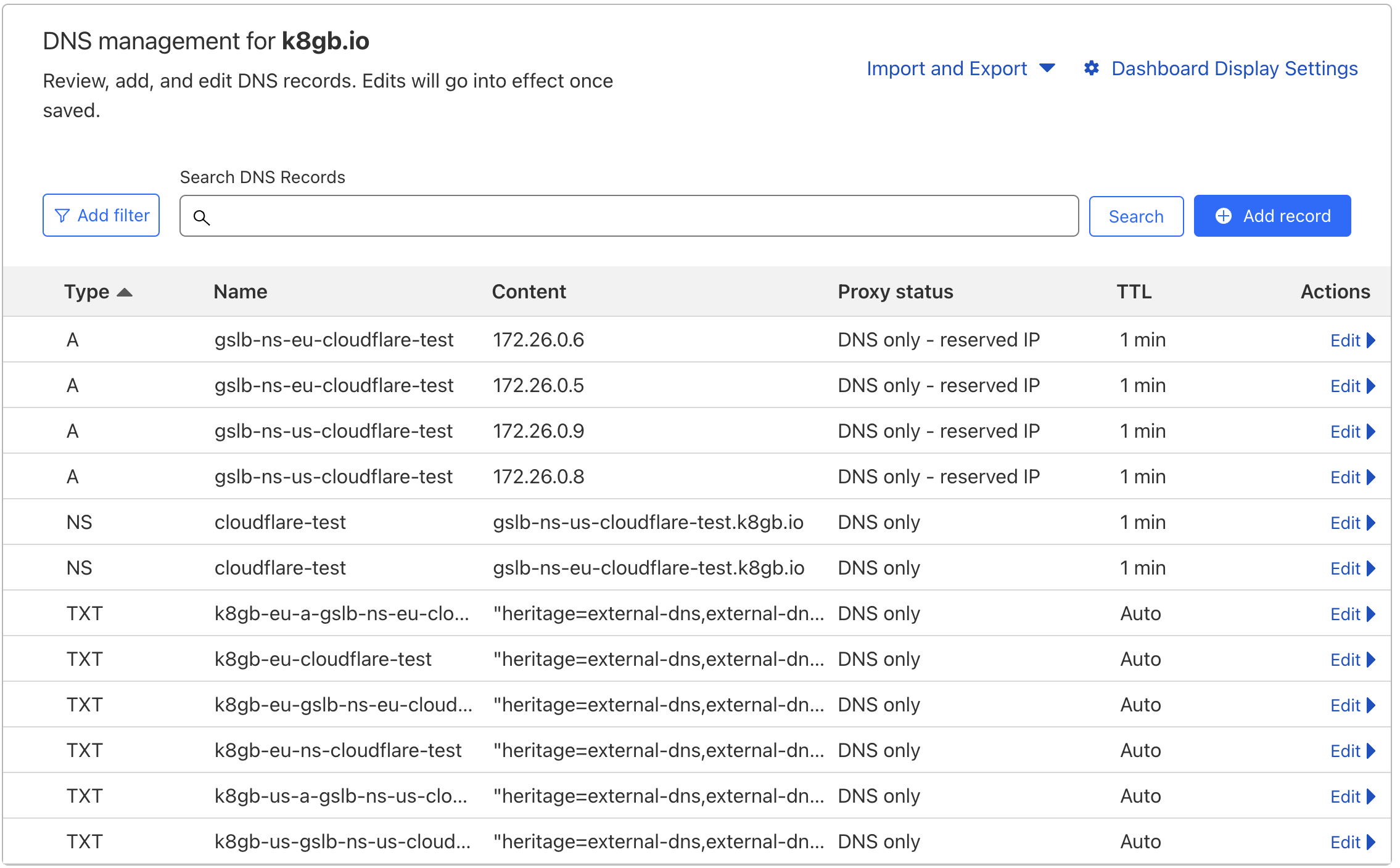General deployment with Cloudflare integration
In this guide, we will demonstrate how to configure k8gb to integrate with Cloudflare for automated zone delegation configuration.
Initial setup
As a prerequisite, we will need two Kubernetes clusters where you want to deploy k8gb and enable global load balancing between them.
You can reuse local clusters from the Infoblox tutorial, the EKS-based setup from Route53 tutorial or any Kubernetes deployment method that is convenient to you.
The specific Kubernetes deployment method is not essential for the focus of this documentation guide.
For simplicity, we will assume that clusters have simple 'eu' and 'us' geotags.
Deploy k8gb with Cloudflare integration enabled
Use helm to deploy a stable release from the Helm repo.
helm repo add k8gb https://www.k8gb.io
Example values.yaml configuration files can be found here
Remember to change the zone-related values to point configuration to your own DNS zone.
k8gb:
dnsZones:
- parentZone: "k8gb.io"
loadBalancedZone: "cloudflare-test.k8gb.io"
Cloudflare-specific configuration
Let's look closer at the Cloudflare section of the configuration examples.
cloudflare:
# -- Enable Cloudflare provider
enabled: true
# -- Cloudflare Zone ID
zoneID: cdebf92e613133e4bb176a14a9c5b730
# -- Configure how many DNS records to fetch per request
# see https://github.com/kubernetes-sigs/external-dns/blob/master/docs/tutorials/cloudflare.md#throttling
dnsRecordsPerPage: 5000
Follow
https://developers.cloudflare.com/fundamentals/setup/find-account-and-zone-ids/
to find your zoneID
Install the k8gb helm chart in each cluster
In eu cluster, execute
helm -n k8gb upgrade -i k8gb k8gb/k8gb --create-namespace -f ./docs/examples/cloudflare/k8gb-cluster-cloudflare-eu.yaml
In us cluster, execute
helm -n k8gb upgrade -i k8gb k8gb/k8gb --create-namespace -f ./docs/examples/cloudflare/k8gb-cluster-cloudflare-us.yaml
Create a Cloudflare secret in each cluster
kubectl -n k8gb create secret generic cloudflare --from-literal=token=<api-secret>
Note: you can create Cloudflare API tokens at https://dash.cloudflare.com/profile/api-tokens
Create test Ingress and Gslb resources
Now we can test the setup with a pretty standard Gslb resource configuration.
apiVersion: k8gb.absa.oss/v1beta1
kind: Gslb
metadata:
name: test-gslb-failover
namespace: test-gslb
spec:
resourceRef:
apiVersion: networking.k8s.io/v1
kind: Ingress
matchLabels:
app: test-gslb-failover
strategy:
dnsTtlSeconds: 60 # Minimum for non-Enterprise Cloudflare https://developers.cloudflare.com/dns/manage-dns-records/reference/ttl/
primaryGeoTag: eu
type: failover
The only unusual thing here is spec.strategy.dnsTtlSeconds that should be of a
minimum 60-second value in case you are operating a non-Enterprise Cloudflare
subscription. The lower values will be rejected by Cloudflare API.
Apply the Gslb and Ingress resources to each cluster.
kubectl apply -f ./docs/examples/cloudflare/test-gslb-failover.yaml
Check Zone Delegation configuration
As a result of the setup, you should observe DNSEndpoint automatically created, similar to the one below:
$ kubectl -n k8gb get dnsendpoints.externaldns.k8s.io k8gb-ns-extdns -o yaml
apiVersion: externaldns.k8s.io/v1alpha1
kind: DNSEndpoint
metadata:
labels:
k8gb.absa.oss/dnstype: extdns
creationTimestamp: "2023-11-12T19:55:20Z"
generation: 3
name: k8gb-ns-extdns
namespace: k8gb
resourceVersion: "5851"
uid: 5d240eb8-1c19-48c3-bf69-508545f52ea4
spec:
endpoints:
- dnsName: cloudflare-test.k8gb.io
recordTTL: 60
recordType: NS
targets:
- gslb-ns-eu-cloudflare-test.k8gb.io
- gslb-ns-us-cloudflare-test.k8gb.io
- dnsName: gslb-ns-us-cloudflare-test.k8gb.io
recordTTL: 60
recordType: A
targets:
- 172.26.0.8
- 172.26.0.9
On the Cloudflare dashboard side, you should observe that NS and glue A records are automatically created:

Troubleshooting
If something is not working as expected with the integration, check the logs of the externalDNS pod that is responsible for the creation of the DNS records with Cloudflare API.
kubectl -n k8gb logs -f deploy/external-dns
